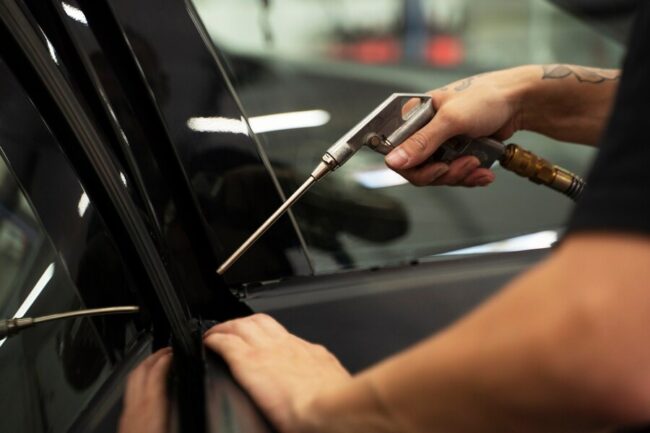Have you ever stepped into a car on a scorching summer day and felt immediate relief from the sweltering heat outside? Or perhaps you’ve walked into a room with large windows, yet the temperature inside feels pleasantly cool and comfortable. These experiences are made possible by a simple yet powerful technology: window tinting.
Window tinting is more than just a cosmetic enhancement for your vehicle or building; it’s a wise investment that can significantly improve your comfort and energy efficiency. One of the key benefits of window tinting is its ability to reject heat, keeping your interior spaces cool even in the hottest weather.
In this article, we’ll explore the science behind heat rejection in window tinting and how it works to maintain a comfortable environment inside your vehicle or building. We’ll delve into the technology behind window tinting films, the mechanisms of heat rejection, and the tangible benefits they offer. Whether you’re a car owner looking to enhance your driving experience or a property owner seeking to improve energy efficiency, understanding the role of heat rejection in window tinting is essential. So, let’s dive in and discover the extraordinary secrets of window tinting!
Understanding Heat Rejection
Understanding heat rejection in window tinting is crucial for appreciating its role in keeping your interior cool. Window tinting films are designed to reject heat by blocking or absorbing infrared (IR) radiation, which is responsible for the heat you feel from the sun. These films are constructed using various materials, such as ceramics, carbon, or dyes, each with heat rejection capabilities.
The effectiveness of heat rejection depends on factors like the type of film used, its thickness, and the quality of installation. By understanding how these films work, you can make informed choices to maximize the heat rejection performance of your window tinting, ensuring a cooler and more comfortable interior environment.
 How Heat Rejection Works
How Heat Rejection Works
Heat rejection in window tinting works through the combined mechanisms of absorption, reflection, and solar energy transmission. Window tinting films are designed with specialized materials that interact with sunlight to reduce the heat entering a vehicle or building. When sunlight, which consists of visible light, infrared (IR) radiation, and ultraviolet (UV) radiation, strikes the window tinting film, each component of the sunlight is handled differently:
- Absorption: Some window tinting films contain materials, such as carbon or dye, that absorb some solar energy, particularly infrared (IR) radiation. This absorption process converts the solar energy into a different form, usually heat, which is then dissipated away from the interior of the vehicle or building.
- Reflection: Other window tinting films are formulated with metalized particles, such as aluminum, that reflect a portion of the solar energy, including both IR and UV radiation. This reflective property prevents significant solar heat from entering the interior, reducing the overall temperature.
- Transmission: While most solar energy is absorbed or reflected, a small percentage still passes through the window tinting film as visible light. The level of visible light transmission (VLT) determines how much light enters the interior, influencing the aesthetic appearance and the heat gain.
By employing these mechanisms, window tinting films effectively reduce the amount of solar heat entering a vehicle or building, helping maintain a cooler and more comfortable interior environment while protecting against UV damage and glare.
Types Of Materials Used In Window Tinting Films For Heat Rejection
- Ceramic Films:
-
-
- Made from ceramic particles that are non-metallic and non-conductive
- Excellent heat rejection properties without interfering with electronic signals
- High durability and scratch resistance
-
- Carbon Films:
-
-
- It contains carbon particles that block a significant amount of infrared (IR) radiation
- It provides good heat rejection and a sleek, matte finish
- It offers UV protection and reduces interior fading
-
- Dyed Films:
-
-
- It consists of a dye layer that absorbs solar energy, including heat and UV rays
- Suitable for enhancing privacy and reducing glare
- Less effective in heat rejection compared to ceramic or carbon films
-
- Hybrid Films:
-
-
- Combine elements of ceramic, carbon, and dyed films for a balance of performance and aesthetics
- Offer varying degrees of heat rejection, UV protection, and glare reduction
- It can be a cost-effective option for those seeking a blend of features
-
- Metalized Films:
-
- Infused with metal particles (such as aluminum) that reflect heat and UV rays
- Provide strong heat rejection and glare reduction
- It may interfere with electronic signals and have a shiny appearance
These materials are used in window tinting films to provide different levels of heat rejection, UV protection, glare reduction, and aesthetic appeal, allowing consumers to choose the film that best suits their needs and preferences.
Benefits of Heat Rejection
- Maintains a comfortable interior temperature by reducing heat buildup
- Reduces the need for excessive use of air conditioning, leading to energy savings
- It helps protect interior furnishings and materials from UV damage and fading
- Improves visibility by reducing glare from sunlight
- Enhances privacy by making it harder for outsiders to see inside the vehicle or building
- Can improve the overall appearance of the vehicle or building with a sleek, uniform tint
- It provides added security by making it more difficult for windows to shatter upon impact
Factors Affecting Heat Rejection Performance
Factors Affecting Heat Rejection Performance in Window Tinting Films include film thickness, quality, and installation. Thicker films typically offer higher heat rejection capabilities, providing more material for absorbing or reflecting heat. The quality of the film also plays a crucial role, with premium films often featuring advanced technologies that enhance heat rejection without significantly reducing visible light transmission.
Proper installation is essential for maximizing heat rejection performance, as even the highest-quality film can underperform if not installed correctly. Professional installation ensures that the film is applied evenly, without air bubbles or gaps that can compromise its effectiveness.
- Film Thickness: Thicker window tinting films offer better heat rejection capabilities due to their increased density and insulation properties.
- Film Quality: High-quality window tinting films with advanced technology and superior materials are more effective in blocking heat and UV rays.
- Film Type: Different types of window tinting films, such as ceramic, carbon, or dyed films, have varying degrees of heat rejection based on their composition and design.
- Installation Quality: Proper installation by experienced professionals ensures that the window tinting film is applied evenly without air bubbles or gaps, maximizing its heat rejection performance.
- Window Condition: The condition of the windows, including their size, shape, and material, can affect how well the window tinting film adheres and performs in rejecting heat.
- Environmental Factors: External factors such as climate, sunlight exposure, and humidity levels can impact the effectiveness of heat rejection in window tinting, with some films performing better in certain conditions than others.
Tips For Maximizing The Heat Rejection Capabilities Of Window Tinting Films
- Choose High-Quality Films: Opt for window tinting films with superior heat rejection properties, such as ceramic or multi-layered, as they perform better than standard films.
- Select the Right Tint Level: Consider the climate and your specific needs when choosing the tint level. Darker tints generally offer higher heat rejection but may not be suitable for all environments or legal requirements.
- Ensure Proper Installation: Professional installation is crucial for maximizing heat rejection. Improperly installed films can create air pockets or bubbles that reduce effectiveness.
- Use UV Blocking Films: Look for window tinting films that offer high UV protection in addition to heat rejection. UV rays contribute to heat buildup and can cause damage to your skin and interior.
- Regular Maintenance: Keep your window tinting clean and in good condition. Dirt and debris can reduce its effectiveness over time. Use gentle cleaning solutions and soft cloths to avoid damaging the film.
- Consider Additional Heat Reduction Methods: Combine window tinting with other heat reduction methods, such as sunshades or reflective window coatings, to enhance heat rejection and maintain a comfortable interior temperature.
 Case Studies Or Examples
Case Studies Or Examples
- A car owner noticed a significant reduction in interior temperatures and improved comfort after installing ceramic window tinting film, even in hot summer conditions.
- A commercial building installed carbon window tinting film on its windows, reducing glare, improving employee comfort, and lowering energy bills due to decreased reliance on air conditioning.
- An RV owner experienced less heat buildup and improved privacy after applying dyed window tinting film to their vehicle’s windows, enhancing their overall travel experience.
- A homeowner observed decreased UV radiation entering their home and better preservation of furniture and flooring colors after installing high-quality window tinting film with high total solar energy rejection (TSER) on their windows.
- A business owner noted increased customer satisfaction and longer-lasting merchandise displays after using window tinting film to reduce heat and UV damage to their products.
- A trucking company reported improved driver comfort and reduced fatigue on long hauls after equipping their fleet with window tinting film to minimize heat buildup in the cabins.
These examples illustrate the diverse benefits of window tinting for different vehicles and buildings, showcasing how heat rejection can enhance comfort, energy efficiency, and protection from UV damage.
Conclusion
Heat rejection in window tinting is crucial in maintaining a comfortable interior temperature and enhancing the overall driving or living experience. By effectively blocking or absorbing infrared radiation, window tinting films reduce heat buildup inside your vehicle or building, allowing for a cooler and more pleasant environment. This not only improves comfort but also helps reduce the load on air conditioning systems, leading to potential energy savings.
Additionally, the protection offered by heat rejection against UV damage and fading of interior furnishings and materials ensures long-term durability and aesthetics. When considering window tinting options, choosing a high-quality film that offers superior heat rejection capabilities can significantly enhance the comfort, energy efficiency, and longevity of your vehicle or building.




